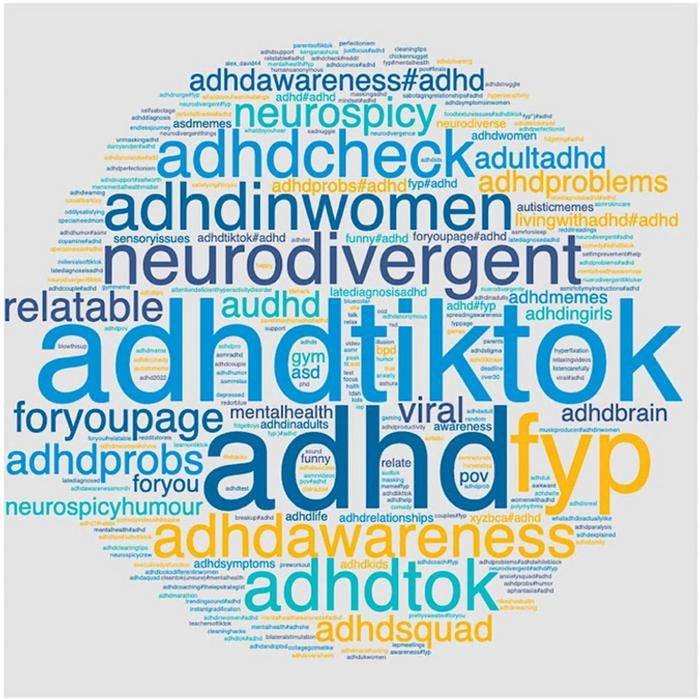Half of the most viewed TikTok videos about ADHD are not in line with scientific literature
Around half of the 100 most popular videos on TikTok about Attention Deficit Hyperactivity Disorder (ADHD) contain statements that diverge from the scientific literature of reference, according to a study published in PLOS ONE. In addition, the research shows that there are discrepancies between young people and mental health professionals about the educational value of the content about ADHD on this social network.

Blandine French - tiktok adhd EN
Blandine French
Senior researcher at the School of Psychology and the Institute of Mental Health at the University of Nottingham (United Kingdom)
Due to the recent nature of social media engagement on platforms such as TikTok, very few studies have been able to evaluate the impact it has. As mentioned by the authors, the huge rise of TikTok ADHD content has only been observed in the last 5 years and little has been published on this. In fact, ADHD fell within the 10 most -viewed health related hashtags on TikTok so we really need to understand more about its impact on those viewing this content.
It is therefore great to see a study starting to address this. This study is very well conducted, with a thorough analysis and robust findings. The rational for the way the study was conducted is sound, well designed and well explained.
One limitation of the study is that the majority of participants in the second study were females (669/843) which does not represent the ADHD general population (ratios of male to female vary from 1:4 male to 1:2) so we must be cautious in generalising the findings.
It would also have been useful to see more detail on what they defined as misinformation. The experts rated according to DSM-V diagnosis (attention, hyperactivity, impulsivity) which is a robust and scientific way of approaching content. However, we know that many things are linked with ADHD but not part of diagnostic symptoms (emotion dysregulation, sleep, social difficulties etc). Therefore, content that would have been rated as misinformation can be relevant (and authors acknowledge this) but would not be scored as such as they are not technically linked with ADHD in terms of strict diagnosis criteria. This nuance would have been good to include and reflect a more holistic approach and understanding of ADHD that is not solely based on criteria but still has significant evidence-based studies behind.
Overall, this paper has some important implications and offers a balanced view of the impact on social media. On one hand it supports how much young people rely on social media, the breadth of reach of this kind of content (over 500 million views) and that there are positives from viewing such videos (sense of community, greater understanding etc). But it also raises concern about viewers relying on this content as educational and support sources. The lack of nuance, evidence-base and reliability of these video is very high. Now this doesn’t mean that it is always bad, but it is to be taken with extreme caution.
The findings also show that the group more prone to highly rate or engage with these videos is the group that is self-diagnosed which is interesting but potentially worrying. The diagnosed group seemed better able to tell the difference between quality of information, while self-diagnosed were not as able to do so.
Therefore, if any person has seen this type of content on TikTok and thinks they may have ADHD, I would say that I am glad they might have found an answer to ongoing difficulties. But I would advise to do some further research from more reliable sources and evidence-based criteria. Social media can be a great source of support but shouldn’t be a place for diagnosis as it is not made for this. It should be used alongside other more reliable methods, sources, and information.
Conflicts of interest: Dr. BF reports personal fees and nonfinancial support from Takeda and Medice.
Philip Asherson - tiktok adhd EN
Philip Asherson
Professor of Molecular Psychiatry at the Institute of Psychiatry, Psychology and Neuroscience at King's College London (United Kingdom)
The methodology is fair as an initial investigation of the association of Tik Tok use and content related to ADHD; and is well conducted. The first study investigates the content of the top 100 Tik Tok watched videos related to #ADHD. This is a reasonable approach to understand how specific the content is to ADHD, rather than mental health more broadly. The second study is limited primarily by the sole participation of psychology students, which suggests that the findings cannot be generalised to a general (unselected) population. Further research is therefore needed. The sample sizes are reasonable for an initial investigation. It is to be commended that the study design was lodged within the Open Science Framework, increasing the robustness of the study findings. Agreement between psychologist ratings was good.
The findings on symptoms in the video are not entirely ‘incorrect’; but fit with my expectations. First it is important to recognise that the TikTok videos reflect personal experience and not that of professional trained mental health specialists. Also, that not all the symptoms commonly experienced by adults with ADHD are specified as specific criteria in DSM-5. Given that, around 49% of the videos were a good reflection of specific (DSM-5) symptoms. However, non-specific symptoms are also commonly seen in people with ADHD and are an independent source of impairment. The prime example of this is emotional dysregulation which is cited as an example of 42% reflecting transdiagnostic symptoms. The paper does not list all of the other transdiagnostic symptoms but other common symptoms include sleep problems (delayed sleep onset), and low self-esteem related to the impairments of ADHD are common as part of ADHD. Without a more detailed evaluation it is not clear that these ‘non-ADHD’ symptoms may also reflect other common aspects of ADHD which are not among the 18 specific DSM symptoms of ADHD. Note that emotional dysregulation is not specific to ADHD, but it is cited in DSM-5 as a common symptom that supports the diagnosis; and is a common part of the lived experience of most adults with ADHD.
So, the other symptoms may not all be ‘incorrect’ but just not specific to ADHD. However, it is possible that this could lead some people to think they might have ADHD unless they also consider the full diagnostic criteria for ADHD (which is not included as an aim in these studies).
It is of interest that those with a formal diagnosis access Tik Tok most, followed by those with self-diagnosis. This suggests that the main driver of looking at Tik Tok videos of ADHD is to learn more about ADHD, rather than the videos leading to excess self-diagnosis.
A more subtle but essential point is that many ADHD symptoms are a continuous trait/dimension in the general population. So there is no clear boundary between those with clinically significant levels of ADHD symptoms and impairments, and those with higher than average levels of ADHD symptoms. Many people who do not meet full ADHD criteria may nevertheless struggle with some ADHD symptoms at times and seek information on better to manage this aspect of their lives. The videos are therefore of more general relevance than only adults meeting full ADHD criteria. Many self-diagnosed people may fall in this category.
It is also true that some people with other mental health problems may conclude they have ADHD, as the videos do not detail the full diagnostic criteria. This indicates the importance of an assessment that considers ADHD alongside other mental health disorders for those that seek help. Similarly, people with ADHD might consider they have an anxiety or mood disorder or personality disorder, when ADHD is the main problem. In general the non-expert Tik Tok videos are not generally specific to ADHD. However, they usually reflect common symptoms experienced by adults with ADHD.
The relationship between ADHD self-diagnosis, video consumption and perception of prevalence only indicates an association but there is no information on the causal relationship. It seems likely that having ADHD or symptoms of ADHD leads to increased TikTok use as one form of information, since those without ADHD consume the less (as expected). While a causal role of watching TikTok on self-diagnosis could be implied or play a role in some cases, this publication provides no information on the causal direction – so should not be interpreted in that way without further research.
Watching these videos may be helpful to people with ADHD to understand the experiences of ADHD they are having. However, it would be important to discuss this with other people with ADHD (ADHD user/support groups could be helpful here) and to seek professional advice.
The conflict of interests and Tik Tok algorithms are a concern and might lead to over diagnosis in some cases – but overall the greater awareness of ADHD is a benefit.
Conflicts of interest: In the last 4 years, Asherson received payments for consultancy and/or educational talks from Takeda, Jannsen, Flynn Pharma, Medice and AGB Pharma, and royalties from PATOSS and Cambridge University. He is Honorary President of the UK Adult ADHD Network (UKAAN).
Vasileia Karasavva et al.
- Research article
- Peer reviewed



